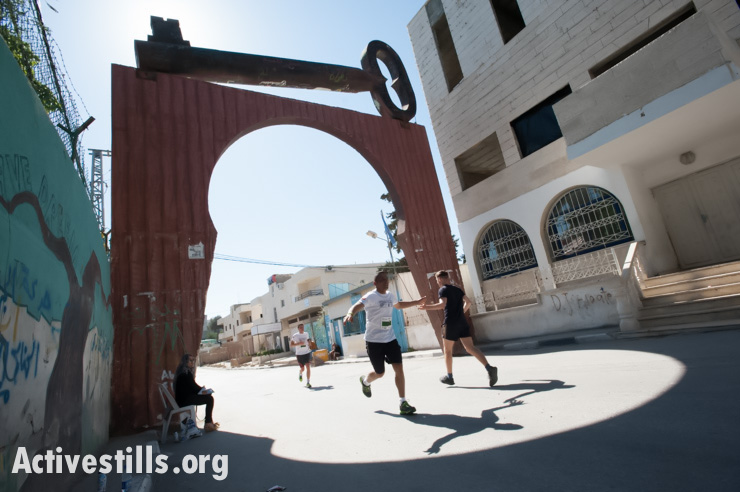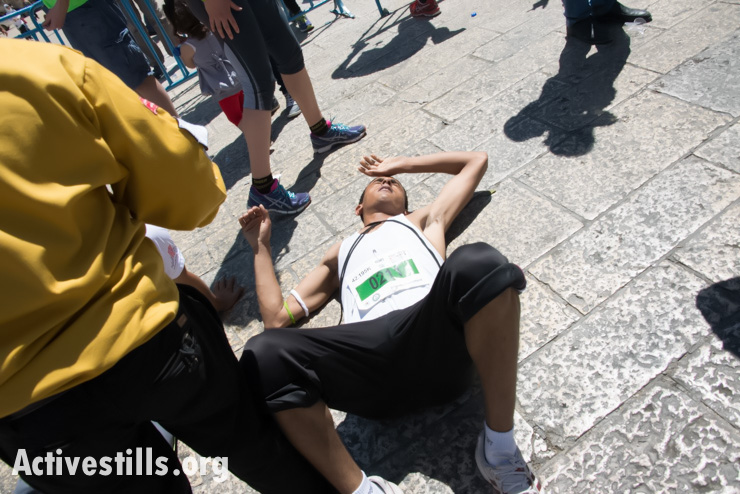Under the theme, ‘Right to Movement,’ some 3,200 runners criss-crossed the streets of the West Bank town of Bethlehem in the second annual Palestine Marathon.
Text and photos: Ryan Rodrick Beiler/Activestills.org

Some 3,200 runners competed in the second annual Palestine Marathon in the streets of the West Bank town of Bethlehem Friday. The race’s theme, “Right to Movement,” is based on Article 13 of the UN Human Rights Charter and highlights the many ways in which Palestinians’ movements are restricted: by the separation wall, checkpoints, roadblocks, and other aspects of the Israeli occupation. As in last year’s inaugural race, marathon runners had to complete two laps of the same route, as organizers were unable to find a single course of 42 uninterrupted kilometers under Palestinian Authority control.
According to B’Tselem, as of February there were 99 permanent checkpoints restricting the movement of Palestinians, including 59 “internal checkpoints,” located well within the West Bank. In addition, the UN Office for the Coordination of Humanitarian Affairs (OCHA) counted 256 surprise “flying checkpoints” in December 2013. Israel has also blocked Palestinian access to some of the main West Bank roads with 500-plus physical obstructions, such as dirt embankments, concrete blocks, iron gates and trenches. Such obstacles prevent vehicles from crossing even in emergencies, and restrict the movement of many pedestrians who may be physically unable to climb over or around them: the elderly, sick persons, pregnant women, and small children. Moreover, some 65 kilometers of roads in the West Bank are restricted for the sole, or practically sole, use of Israeli settlers. Palestinians are often barred from even crossing some of these roads with vehicles, thereby requiring them to get out of the vehicle, cross the road on foot, and find an alternative mode of transportation on the other side.
Another key case in point was Israel’s denial of permission for Palestinian Olympic runner Nader al-Masri’s to travel from his home in the Gaza Strip to compete in this year’s race. Reuters quoted an Israeli government official responsible for permits as saying: “the marathon is supported by the Palestinian Authority and is tainted by political shades which delegitimize the State of Israel.” The majority of the Gaza residents are routinely prohibited by the Israeli authorities from traveling to Jerusalem or the West Bank for any reason, with the primary exception of medical cases.
The Palestine Marathon comes just weeks after Palestinian activists protested the Jerusalem Marathon, which passed through parts of East Jerusalem, which is considered occupied Palestinian territory under international law. The Palestinian BDS (boycott, divestment, sanctions) National Committee, called for a boycott of race sponsors New Balance and Crowne Plaza, saying that the Jerusalem Marathon “is used to cover up Israel’s image around the world while acting as a smokescreen to its illegal annexation of and gradual ethnic cleansing of Palestinians from the occupied city.” Activists waving Palestinian flags attempted to disrupt the race at various points, but were dispersed by Israeli police.
The Palestine Marathon saw little overt political tension, other than the occasional gesture or slogan shouted at a gun-toting Israeli soldier stationed in a watchtower atop the separation wall.
The race was won simultaneously by two Danish runners, Morten Hvidtfelet and Anders Roemer, who ran the entire race together and finished in two hours, 51 minutes, and 13 seconds. Last year’s winner, Palestinian Abdel Nasser Awajneh of Jericho, finished third.
Palestinians and internationals of all ages and abilities competed in 5K, 10K, half marathon, and full marathon versions of the race. After inaugurating the event last year with 600-plus runners, this year’s six-fold increase in participation indicates the event’s growing popularity and unique potential to bring international attention to the challenges faced every day by Palestinians living under the movement restrictions of occupation.













